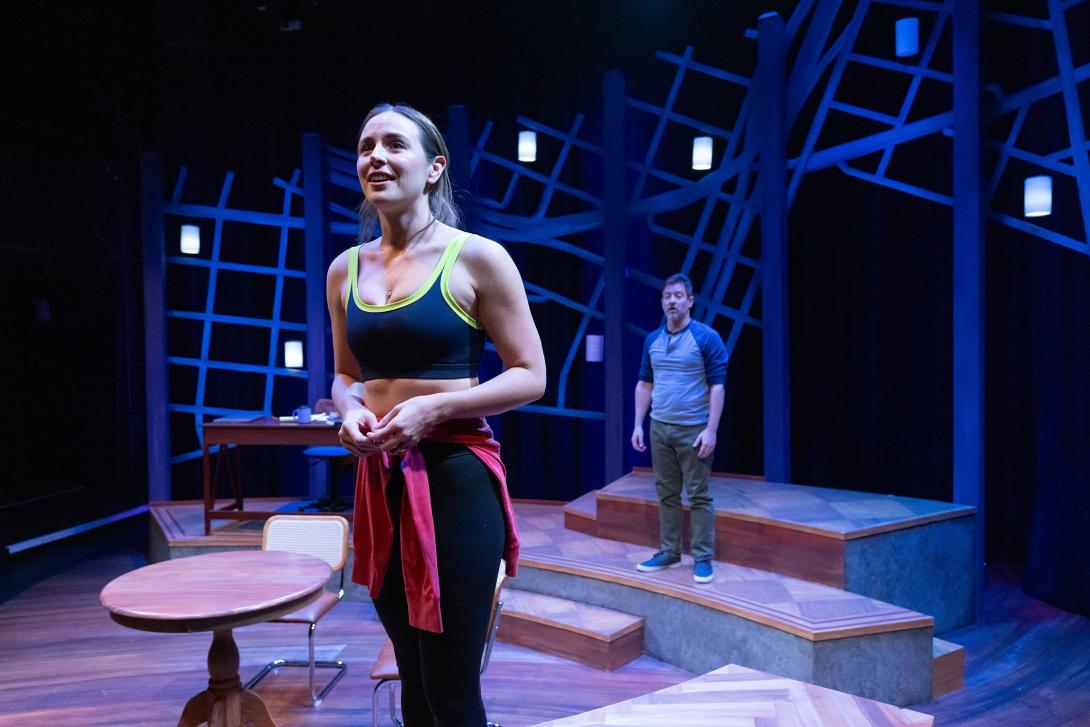Theatre Design Is A Creative Journey for Will Lowry
When theatregoers see a set designed by Lehigh associate professor of theatre Will Lowry, they’re seeing the result of a creative journey.
“What I think is unique about my process as a designer is that I often like to do multiple sketches of vastly different approaches,” says Lowry. “I may bring six to 12 different designs to the table. In sketching different ideas, I don’t try to solve every problem.”
Considering multiple scenic designs encourages collaboration among the play’s creative team, inviting input from the director and the lighting and costume designers. Such collaboration in creating the world of the play is integral in theatre.
“I revel in having multiple ideas so that we can design as collaboratively with the full team as possible,” says Lowry, who earned an MFA in theatre design from UNC Greensboro. As a multidisciplinary designer he has created scenic, lighting, media, and costume designs professionally and at Lehigh.
Lowry used his multi-faceted approach to design the set for a production of The Wanderers at Philadelphia’s Lantern Theater Company. The play, written by Anna Ziegler, opened the company’s 2024-2025 season in September.
He explains that before he produces sketches, research helps to generate ideas. It may include what he calls denotative research that answers questions like “what did a writer’s office in 1940s England look like?” Other research might be connotative research exploring images and materials that evoke a mood, exploring textures, line, shape, and patterns.
Inspiration for some of the designs used in The Wanderers came from considering the work of visual artists. Because the play’s characters are Jewish, Lowry researched the work of Jewish artists Anni Albers and Richard Serra. The graceful curves in one of Serra’s sculptures inspired the curved platforms used on stage for The Wanderers.
The pattern in one of Albers’ works recalled the grid-like pattern of city streets. It eventually led Lowry to design a backdrop that is the grid of streets in Williamsburg, Brooklyn, where the play takes place. “One character talks about walking through the streets of Williamsburg, so this character of Williamsburg is still present, kind of looming in the abstract,” says Lowry.

Lowry, who earned an undergraduate degree with a double major in theatre arts and computer science, frequently leverages technology in his process. As a graduate student, he was the first in his class to use digital rendering in addition to hand drawing. He now uses artificial intelligence (AI), not to design, but to augment his research. For example, experimentations with AI yielded examples of parquet floors inspiring his paint treatment of floors in The Wanderers. He also has used virtual reality (VR) to create panoramas, allowing a play’s director to wear a VR headset and stand in the virtual space.
Some design decisions are driven by requirements of the play. “When we look at the structure of a play from a design standpoint, that tells us something about how we need to create the space,” Lowry says. The Wanderers’ story revolves around two married couples separated by decades, with the play’s action moving between the eras. Using few realistic details and a minimal set allows the characters to move fluidly in time. Some elements in the set do double duty: a platform can become a bed.
Lowry notes that a key line in the script declares that we are never aware of miracles – especially if we are inside of them. It reinforced the decision to create a spare setting for the play. “The abstraction is also part of the [play’s] message, because it's about the characters not noticing the details in their own lives,” Lowry says.
A minimalistic approach also involves the audience. “We’re trusting the audience to conjure the environment with us,” he adds.
The Wanderers is Lowry’s second collaboration with Lantern Theatre. He was the scenic and lighting designer for the company’s production of The Royale in 2022. His work earned nominations from the Barrymore Awards for Excellence in Theatre. The awards recognize work in Philadelphia theatre. The play itself won Barrymores for best direction and overall production.
Embracing the creative journey is an approach that he tries to share with his students.
“It’s all about the process,” Lowry emphasizes. “If you think just about the final result, it’s very daunting to create an original idea that answers this theatrical riddle.”
Coming up with the perfect design can be daunting for students. He encourages them to combine research with their creative instincts to consider multiple options. “You take a meandering path of starts and stops combined with experience and visual research, and that’s how you get there,” he states. “...Stop trying to think of the correct answer because there’s not a correct answer. There’s only the best answer for that moment in your life…”
He shares early sketches he’s created that were less effective solutions to re-assure students that both good and bad ideas are necessary parts of the process.
“I find it gives a transparency about the occasional terror of creation,” Lowry says.

